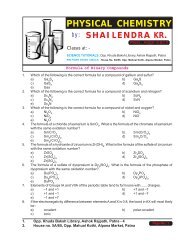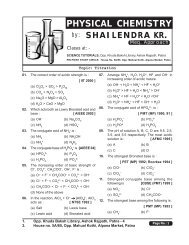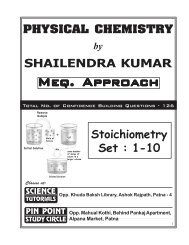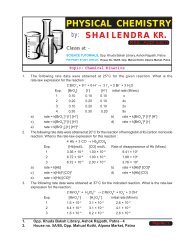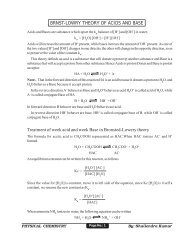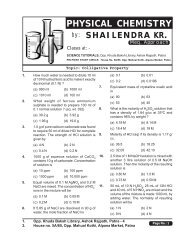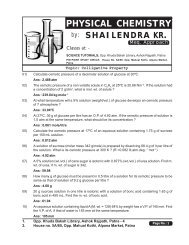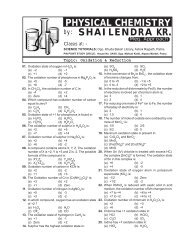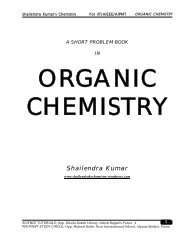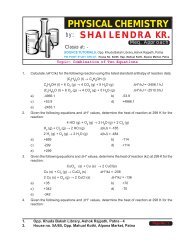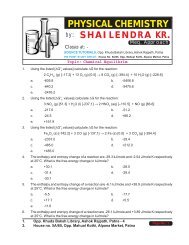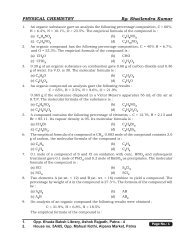Electrochemistry & Ionic equilibrium - Shailendra Kumar Chemistry
Electrochemistry & Ionic equilibrium - Shailendra Kumar Chemistry
Electrochemistry & Ionic equilibrium - Shailendra Kumar Chemistry
You also want an ePaper? Increase the reach of your titles
YUMPU automatically turns print PDFs into web optimized ePapers that Google loves.
join<br />
FOUNDATION/TARGET BATCH<br />
to grab TOP rank in<br />
IIT-JEE / AIEEE / AIPMT<br />
CHEMISTRY<br />
Through most innovating teaching style by:<br />
<strong>Shailendra</strong> <strong>Kumar</strong><br />
consult for<br />
Meq. Approach<br />
FREE CRASH COURSE<br />
For: AIPMT (Mains) / AIEEE - 2012<br />
Our best rankers of 2011<br />
2613<br />
Ashnil Kr.<br />
4088<br />
Rahul Kr.<br />
IIT-JEE<br />
booklet of ELECTROCHEMISTRY and IONIC EQUILIBRIA<br />
www.shailendrakrchemistry.wordpress.com<br />
SCIENCE<br />
TUTORIALS<br />
PIN POINT<br />
STUDY CIRCLE<br />
6431<br />
Harshit<br />
10310<br />
Jayati<br />
10537<br />
Shahid Perwez<br />
AIEEE<br />
713<br />
Asim Ahmad<br />
983<br />
Navin Kr.<br />
AIPMT<br />
# CELL: 9386594202, 9334217743<br />
[kqnk c['k ykbczsjh ds lkeus] v'kksd jktiFk] iVuk<br />
gkml ua0&5A/65, egqvy dksBh ds lkeus] bUVjus'kuy<br />
Ldwy ds cxy esa] vYiuk ekdsZV] iVuk
Knowledge of thermodynamics, reaction quotient and<br />
redox reaction are very important for solving the problem<br />
of electrochemistry<br />
RULE TO SOLVE PROBLEM OF ELECTROCHEMISTRY<br />
§ Rule (1)<br />
A<br />
B<br />
A +2 + 2e ∆G 1<br />
= –0.2kcal ....(i)<br />
B +2 + 2e ∆G 2<br />
= +0.4 kcal ....(ii)<br />
According to the rule of spontaneity, reaction (i) is<br />
spontaneous but reaction (ii) is non-spontaneous. To<br />
gain full cell reaction, we convert non-spontaneous<br />
reaction into spontaneous reaction.<br />
Same : A A +2 + 2e; ∆G 1<br />
= –0.2kcal<br />
Change : B +2 + 2e B; ∆G 2<br />
= –0.4 kcal<br />
A + B +2 A +2 + B ∆Grxn<br />
∆Grxn = ∆G 1<br />
+ ∆G 2<br />
= (–0.2kcal) + (–0.4 kcal)<br />
= – 0.6 kcal<br />
To Calculate Emf of reaction<br />
§ Rule (2)<br />
∆G = – nFE E = –∆G/nF<br />
If both half cell reactions are non-spontaneous, then<br />
we convert more non-spontaneous reaction into<br />
spontaneous reaction to gain full cell reaction.<br />
A A +2 + 2e ∆G 1<br />
= +0.2 kcal ....(i)<br />
B B +2 + 2e ∆G 2<br />
= +0.5 kcal ....(ii)<br />
Reaction (i) is less non-spontaneous and reaction (ii) is<br />
more non-spontaneous.<br />
Change : B +2 + 2e B ∆G 2<br />
= –0.5 kcal<br />
Same : A A +2 + 2e ∆G 1<br />
= +0.2 kcal<br />
B +2 + A B + A +2 ∆Grxn<br />
∆Grxn = ∆G 1<br />
+ ∆G 2<br />
= (–0.5) + (0.2) kcal = –0.3 kcal<br />
* Spontaneity from ∆G<br />
4<br />
3<br />
2<br />
1<br />
0<br />
–1<br />
–2<br />
–3<br />
Non-spontaneoity<br />
increases<br />
∆G = 0 (Rxn is at <strong>equilibrium</strong>)<br />
Spontaneoity<br />
increases<br />
–4<br />
Greater the positive value (+ve) of free energy<br />
greater will be non-spontaneity.<br />
Greater the negative value (–ve) greater will be<br />
spontaneity<br />
2for free theory, questions, e-books and videos, visit: www. shailendrakrchemistry.wordpress.com<br />
§ Rule (3)<br />
If both half cell reactions are spontaneous then we<br />
convert less spontaneous reaction into nonspontaneous<br />
reaction.<br />
A A +2 + 2e ∆G 1<br />
= –0.5 kcal (more spontaneous)<br />
B B +2 + 2e ∆G 2<br />
= –0.2 kcal (less spontaneous)<br />
Same : A A +2 + 2e ∆G 1<br />
= –0.5 kcal<br />
Change : B +2 + 2e B ∆G 2<br />
= +0.2 kcal<br />
§ Rule (4)<br />
A<br />
A + B +2 B + A +2 ∆Grxn<br />
∆G rxn = – 0.5 kcal + 0.2 kcal = – 0.3 kcal<br />
B<br />
A +2 + 2e ∆Gº 1<br />
= –0.2 kcal ...(i)<br />
B +2 + 2e ∆Gº 2<br />
= +0.5 kcal...(ii)<br />
If ∆Gº given in the half cells then spontaneity of the<br />
reaction not determined by ∆Gº. We convert ∆Gº into<br />
∆G by following equation.<br />
∆G = ∆Gº + RT ln Q<br />
If Q = 1 , then ∆G = ∆Gº<br />
∆G 1<br />
= ∆Gº 1<br />
+ RT ln [A +2 ] .......(i)<br />
∆G 2<br />
= ∆Gº 2<br />
+ RT ln [B +2 ] .......(ii)<br />
§ Rule (5)<br />
If emf of the half cell given in the problem then we predict<br />
the spontaneity of reaction by emf.<br />
∆G = – nFE<br />
* Spontaneity from E<br />
Greater the reduction potential greater will be<br />
ease of reduction. Greater the oxidation potential greater<br />
will be ease of oxidation.<br />
§ Rule (6)<br />
A<br />
B<br />
4<br />
3<br />
2<br />
1<br />
0<br />
–1<br />
–2<br />
–3<br />
–4<br />
Spontaneoity<br />
increases<br />
E = 0 (Rxn is at <strong>equilibrium</strong>)<br />
Non - spontaneoity<br />
increases<br />
A +2 + 2e Eo.p = –0.2 Volt (non-spontaneous)<br />
B +2 + 2e Eo.p = +0.5 Volt (Spontaneous)<br />
Same : B B +2 + 2e EO.P. = +0.5 Volt<br />
Change: A +2 + 2e A ER.P. = +0.2 Volt<br />
B + A +2 B +2 +A Ecell<br />
Ecell = EO.P + ER.P = 0.5 + 0.2 = 0.7 Volt
§ Rule (7)<br />
A<br />
B<br />
A +2 + 2e EO.P. = +0.5 Volt (more spontaneous)<br />
B +2 + 2e EO.P. = +0.3 Volt (Less spontaneous)<br />
Same : A A +2 + 2e EO.P. = +0.5 Volt<br />
Change: B +2 + 2e B ER.P. = –0.3 Volt<br />
A + B +2 B + A +2 Ecell<br />
Ecell = EO.P. + ER.P. = +0.5 – 0.3 Volt = +0.2 Volt<br />
§ Rule (8)<br />
A<br />
B<br />
A +2 + 2e EO.P.= – 0.5 Volt (more spontaneous)<br />
B +2 + 2e EO.P. = – 0.2 Volt (Less spontaneous)<br />
Same : B B +2 + 2e EO.P. = –0.2 Volt<br />
Change: A +2 + 2e A ER.P. = +0.5 Volt<br />
A + B +2 B + A +2 Ecell<br />
Ecell = EO.P. + ER.P. = –0.2 + 0.5 Volt = +0.3 Volt<br />
§ Rule (9)<br />
A<br />
B<br />
A +2 + 2e EºO.P. = +0.5 Volt.....(i)<br />
B +2 + 2e EºO.P. = –0.2 Volt.....(ii)<br />
Spontaneity of reaction not determined by standard emf<br />
it is determined by following equation.<br />
E E n A<br />
E E n B<br />
Ο + 2<br />
= − (0.0592 )log[ ]<br />
O . P . O . P .<br />
Ο + 2<br />
O . P .<br />
=<br />
O . P .<br />
− (0.0592 )log[ ]<br />
Greater the O.P. greater will be ease of oxidation.<br />
HIT AND TRIAL METHOD<br />
We determined spontaneity of reaction by Eº value,<br />
however it is not correct. These are two possible result<br />
one is correct and other is incorrect. If Emf of the cell is<br />
+ve then our result is correct, but Emf of the cell is –ve,<br />
then our result is incorrect, to gain correct result we<br />
convert oxidation half cell into reduction half cell and<br />
reduction half cell into oxidation half cell.<br />
Rule for converting oxidation half cell into<br />
reduction half cell and vice-versa<br />
* A A +2 + 2e EO.P. = –0.2 Volt<br />
If you want to gain reduction half cell then<br />
A +2 + 2e A ER.P. = +0.2 Volt<br />
* B B +2 + 2e EO.P. = +0.5 Volt<br />
If you want to gain reduction half cell then<br />
B +2 + 2e B ER.P. = –0.5 Volt<br />
§ Rule (10) :<br />
A A +2 + 2e EO.P. = 0.2 Volt<br />
B +2 + 2e B ER.P. = 0.5 Volt<br />
Ecell = ?<br />
3for free theory, questions, e-books and videos, visit: www. shailendrakrchemistry.wordpress.com<br />
To calculate Ecell we convert all the half cell reactions<br />
are in same type (either oxidation half or reduction half)<br />
(i) Convert both reaction into oxidation half<br />
A A +2 + 2e EO.P. = 0.2 Volt<br />
B B +2 + 2e EO.P. = –0.5 Volt<br />
(ii) Convert both reaction into reduction half cell<br />
A +2 + 2e A ER.P. = –0.2 Volt<br />
B +2 + 2e B ER.P. = 0.5 Volt<br />
Same : B +2 + 2e B ER.P. = 0.5 Volt<br />
Change : A A +2 + 2e EO.P. = +0.2 Volt<br />
B +2 + A<br />
A +2 + B<br />
Ecell = 0.7 Volt<br />
§ Rule (11) :<br />
For following type half cell reaction hybrid reaction<br />
quotients (mixture of Qp and Qc) used in place of Qc or<br />
Qp<br />
« H 2<br />
2H + + 2e (no. of electron used = 2)<br />
Q<br />
Hybrid<br />
=<br />
+ 2<br />
[ ] /<br />
H mol litre<br />
( P ) atm<br />
H2<br />
« 1/2H 2<br />
H + + 1e (no. of electron used = 1)<br />
Q<br />
Hybrid<br />
+<br />
[ H ]<br />
=<br />
( P )<br />
1/2<br />
H 2<br />
« Cl 2<br />
+ 2e 2Cl – (no. of electron used = 2)<br />
Q<br />
Hybrid<br />
− 2<br />
[ Cl ]<br />
=<br />
( P )<br />
Cl 2<br />
« Cl – Cl 2<br />
+ 1e (no. of electron used = 1)<br />
Q<br />
Hybrid<br />
§ Rule(12) :<br />
( P )<br />
=<br />
[ Cl − ]<br />
1/2<br />
Cl 2<br />
Emf is mass or mole independent property (intensive<br />
property), but free energy is mass or mole dependent<br />
property (Extensive property)<br />
H 2<br />
2H + + 2e; EO.P. = x volt, ∆G = – 2Fx<br />
1/2H 2<br />
H + + 1e; EO.P. = x volt, ∆G = – Fx<br />
Emf of the reaction not depends on stoichiometry coeff.<br />
Example : 2X+ 3y 5 A Ecell = x volt<br />
X+ y A Ecell = x volt<br />
§ Rule (13) :<br />
If reaction is spontaneous in forward direction then nonspontaneous<br />
in reverse direction and vice-versa.<br />
Magnitude of Emf and ∆G are same but sign is reverse.<br />
A A +2 + 2e; EO.P. = X volt , ∆G = – 2FX<br />
A +2 + 2e A ∆G = +2 FX, ∆G = – nFE<br />
∆G = – nFER.P.<br />
ER.P. =<br />
∆G/–nF =2FX / –2F = –X volt
§ Rule (14) :<br />
If two half cell (no. of electron same or different)<br />
produces full cell reaction then for simplicity we add<br />
directly emf of half cell not ∆G. Addition of ∆G gives<br />
same result but process is lengthy.<br />
A A +2 + 2e E 1<br />
B +2 + 2e B E 2<br />
B +2 + A A +2 + B Ecell = E 1<br />
+ E 2<br />
If we proceed this problem by ∆G then.<br />
A A +2 + 2e ∆G 1<br />
= –2FE 1<br />
B +2 + 2e B ∆G 2<br />
= –2FE 2<br />
B +2 + A A +2 + B ∆Grxn = ∆G 1<br />
+ ∆G 2<br />
–2FEcell = –2FE 1<br />
– 2FE 2<br />
Ecell = E 1<br />
+ E 2<br />
If no. of electron involved and apparent in<br />
reaction then reaction is half cell. But if no. of electron<br />
involved but not apparent in the reaction then reaction<br />
is full cell reaction.<br />
Example:<br />
« Fe Fe +3 + 3e oxidation half cell, n=3<br />
« Fe +3 + 1e Fe +2 reduction half cell, n= 1<br />
« 2Fe +3 + 3I – 2Fe +2 –<br />
+I 3<br />
full cell rxn, n=2<br />
«<br />
–<br />
MnO 4<br />
+ 4H + +3e 2H 2<br />
O+MnO 2<br />
reduction half cell, n = 3<br />
« Fe +2 Fe +3 + 1e oxidation half cell, n=1<br />
If two half cell reaction having different no. of<br />
electron provide full cell reaction then we also add Emf<br />
for simplicity.<br />
Example :<br />
2× (A A +3 +3e) E 1<br />
, ∆G 1<br />
= –6FE 1<br />
3× ( B +2 + 2e B) E 2<br />
, ∆G 2<br />
= –6FE 2<br />
2A + 3B +2 2A +3 +3B, ∆Grxn = –6FE 3<br />
∆Grxn = ∆G 1<br />
+ ∆G 2<br />
= –6FE 1<br />
– 6FE 2<br />
= –6FE 3<br />
E 3<br />
= E 1<br />
+ E 2<br />
§ Rule (15) :<br />
If two half cell produces third half cell then we should<br />
not added Emf directly. To calculate emf of third half<br />
cell we add ∆G,<br />
A A +3 + 3e ; E 1<br />
, ∆G 1<br />
= –3FE 1<br />
B +2 + 2e B ; E 2,<br />
∆G 2<br />
= –2FE 2<br />
A + B +2 A +3 + B + 1e E 3<br />
¹ E 1<br />
+ E 2<br />
∆G 3<br />
= ∆G 1<br />
+ ∆G 2<br />
–1FE 3<br />
= –3FE 1<br />
+ (–2FE 2<br />
)<br />
E 3<br />
= 3E 1<br />
+ 2E 2<br />
§ Rule (16) :<br />
For writing shorthand notation or cell representation of<br />
electrochemical cell following conventions are used.<br />
A A +2 + 2e EO.P = 0.5 volt<br />
B +2 + 2e B ER.P = 0.2 volt<br />
A + B +2 B + A +2 Ecell = 0.7 volt<br />
4for free theory, questions, e-books and videos, visit: www. shailendrakrchemistry.wordpress.com<br />
This electrochemical cell represented as follows.<br />
Note :<br />
(a)<br />
(b)<br />
(c)<br />
(d)<br />
(e)<br />
A | A || B | B<br />
14243 14243<br />
+ 2 + 2<br />
[ C1] [ C<br />
2]<br />
. . . R. H . S .<br />
L H S<br />
Oxidation half cell always represented in L.H.S<br />
and reduction half cell always represented in<br />
R.H.S.<br />
Single vertical line placed in L.H.S denote<br />
anode and R.H.S denote cathode<br />
Cathode is known as +ve terminal but anode is<br />
known as –ve terminal in electrolytic cell.<br />
C 1<br />
denotes concentration of A +2 and C 2<br />
denotes<br />
concentration of B +2 .<br />
Reaction quotient of this representation is:<br />
Q =<br />
+ 2<br />
[ A ][ B ]<br />
+ 2<br />
[ A][ B ]<br />
(f) Flow of electron takes place from left to right<br />
(anode to cathode), but flow of current takes<br />
place from right to left (cathode to anode)<br />
(g) No. of electron involved = 2<br />
(h) Ecell for this representation calculated as follows<br />
E = E −<br />
0 0.0592<br />
cell cell log Q<br />
2<br />
CONCEPT OF SPONTANEITY<br />
For the complete study of reaction knowledge of<br />
thermodynamics and chemical kinetics are essential.<br />
Thermodynamics tell us about spontaneity of<br />
reaction (Reaction is spontaneous or not). Chemical<br />
kinetics tells us about the rate of reaction (Reaction is<br />
fast or slow). Spontaneity of the reaction is determined<br />
by thermodynamic parameter like ∆G, ∆S (universe) and<br />
value of emf (For oxidation, Reduction or Redox<br />
Reaction)<br />
Entropy Change (∆S)<br />
Entropy is thermodynamic state quantity that is measure<br />
of randomness or disorder of the molecule of the<br />
system.<br />
Explanation of entropy on the basis of probability<br />
left<br />
bulb<br />
right<br />
bulb<br />
no. of molecule relative prob. of finding all<br />
molecules in left bulb<br />
A (1 molecule) PA = ½ = (½) 1<br />
A,B (2 molecules) PAB = PA×PB = (½) 2<br />
A,B,C....(n molecules) PABC...... = (½) n<br />
6.023 × 10 23 (½) 6.023× 1023 –6.023× 1023<br />
= 2
PA = Probability of finding molecule A<br />
PB = Probability of finding molecule B<br />
PA ×PB = Probability of finding molecule A and B at<br />
the same time<br />
In probability × denotes ‘AND’<br />
+ denotes ‘OR’<br />
From above example, it is clear that as no of molecules<br />
increases probability (chance) of finding of molecule at<br />
the one place decrease.<br />
According to 2nd law of thermodynamics entropy of<br />
universe always increase in spontaneous process.<br />
Surrounding : The rest part of the universe other than<br />
the system is called surrounding.<br />
System<br />
Example :<br />
Melting of ice at 10ºC. ∆S universe = +ve<br />
Melting of ice at 0ºC ∆S universe = 0<br />
Melting of ice at –10ºC ∆S universe = –ve<br />
For spontaneous process :<br />
∆Ssystem + ∆Ssurrounding = ∆Suniverse<br />
(+ve or, –ve) (+ve or –ve) (always +ve)<br />
∆G = ∆H – T∆S .................. (1)<br />
∆G = Free energy, ∆H = Heat enthalpy<br />
∆S = Change in entropy<br />
Eq. (1) is multiplied by –(1/T)<br />
∆G ∆H T ∆Ssys<br />
∆H<br />
− = − − = − + ∆S<br />
T T −T T<br />
∆G<br />
⎛ ∆H<br />
− = ∆ S + ∆ S = ∆S ⎜Q<br />
− = ∆S<br />
T<br />
⎝ T<br />
sys<br />
surro sys universe surro<br />
⇒ ∆ G = −T ∆ Suniverse<br />
V. V.<br />
I<br />
« Consider The melting of Ice<br />
H 2<br />
O (s) + heat → H 2<br />
O (l)<br />
∆H = 6.03 × 10 3 J/mol<br />
∆S system = 22.1 J/K mol<br />
Condition (1) melting of ice at –10ºC (Below M.P.)<br />
Temp = 263 K; ∆H = 6.03 × 10 3<br />
∆S system = 22.1 J/K<br />
∆S surro = –∆H/T =–6.03 × 10 3 / 263 = – 22.9 J/K ∆<br />
universe = ∆S sys + ∆S surro = 22.1–22.9 = –0.8 J/K<br />
∆S universe is –ve hence process is not spontaneous<br />
∆G = – ∆Suniverse × T = – (– 0.8) × 263 = 2.1 × 10 2 J<br />
∆G is +ve hence process is non–spontaneous.<br />
we can calculate ∆G from eq. ∆G = ∆H – T∆S also,<br />
∆G = 6.03 × 10 3 – 263 × 22.1 = 2.1 × 10 2 J<br />
⎞<br />
⎟<br />
⎠<br />
S<br />
5for free theory, questions, e-books and videos, visit: www. shailendrakrchemistry.wordpress.com<br />
Condition (2) melting of ice at 0ºC (at M.P.)<br />
Temp = 273 K; ∆H = 6.03 × 10 3<br />
∆G = ∆H – T∆S = 6.03 × 10 3 – 263 × 22.1 = 0<br />
∆G =0 (process is at <strong>equilibrium</strong>)<br />
∆Suniverse = ∆Ssystem + ∆Ssurro<br />
= 22.1 – (6.03 × 10 3 /273) = 0<br />
Condition (2) melting of ice at 10ºC (above M.P.)<br />
Temp = 283 K; ∆H = 6.03 × 10 3<br />
∆G = ∆H – T∆S = 6.03 × 10 3 – 263 × 22.1<br />
= –2.2 × 10 2 Joule<br />
Process is spontaneous.<br />
Q : By which statement we can say confirmly process<br />
is spontaneous.<br />
(a) ∆S system is +ve (f) ∆S universe is –ve<br />
(b) ∆S system is –ve (g) ∆G is +ve<br />
(c) ∆S surro is +ve (h) ∆G is –ve<br />
(d) ∆S surro is –ve (i) EMF is +ve<br />
(e) ∆S universe is +ve (j) EMF is –ve<br />
Ans: (e), (h) and (i)<br />
* Relation of ∆G with emf is ∆G = –nFE<br />
* Relation of ∆G with ∆Suniverse is ∆G = –T∆Suniverse<br />
§ Conditions for Spontaneity<br />
(a)<br />
condition ∆G ∆Suniverse EMF<br />
Spontaneous<br />
reaction<br />
Non-spontaneous<br />
reaction<br />
Reaction is at<br />
<strong>equilibrium</strong><br />
– ve<br />
+ve<br />
0<br />
THERMODYNAMIC EQUILIBRIA<br />
On the basis of free energy<br />
∆G = ∆Gº + RT lnQ (Q may be Qp and Qc)<br />
At <strong>equilibrium</strong> condition Q = 0, ∆G = 0<br />
∆Gº = –RT lnK (K may be Kp or Kc)<br />
0 0<br />
−∆G<br />
⎛ −∆G<br />
⎞<br />
lnK = ⇒ K = anti ln⎜ ⎟<br />
RT<br />
⎝ RT ⎠<br />
( −∆G 0 / RT )<br />
⇒ K = e<br />
+ ve<br />
–ve<br />
Equilibrium constant (Kp or Kc) can be<br />
calculated by above equation.<br />
0<br />
+ ve<br />
– ve<br />
0
(b)<br />
(c)<br />
On the basis of entropy<br />
∆S reaction = ∆Sº reaction – RlnQ<br />
At <strong>equilibrium</strong> Q = K, ∆S reaction = 0<br />
∆Sº reaction = R lnK<br />
0 0<br />
−∆S<br />
⎛<br />
reaction<br />
−∆S<br />
⎞<br />
reaction<br />
lnK = ⇒ K = anti ln<br />
R<br />
⎜<br />
R ⎟<br />
⎝ ⎠<br />
0<br />
( reaction / )<br />
⇒ K = e ∆S R<br />
Equilibrium constant (Kp or Kc) can be<br />
calculated by above equation.<br />
On the basis of electromotive force for<br />
Oxidation, Reduction and Redox reaction.<br />
∆G = ∆Gº + RT ln Q ........(1)<br />
also, ∆G = – nFE and, ∆Gº = – nFEº<br />
eq. (1) can be also written as<br />
–nFE = –nFEº + RT ln Q........(2)<br />
eq. (2) is divided by nF<br />
RT<br />
nF<br />
0<br />
E = E − lnQ<br />
At 25ºC this equation changes into<br />
0 0.0592 E = E − lnQ<br />
n<br />
At <strong>equilibrium</strong>, Q = K and E = 0.<br />
REACTION QUOTIENT<br />
When reactants and products of a given<br />
chemical reaction are mixed it is useful to know whether<br />
the mixture is at <strong>equilibrium</strong>, and if not, in which direction<br />
the system will shift to reach <strong>equilibrium</strong>.<br />
If the concentration of one of the reactants or<br />
product is zero, the system will shift in the direction that<br />
produces the missing component. However, if all the<br />
initial concentrations are non zero, it is more difficult to<br />
determine the direction of the move toward <strong>equilibrium</strong>.<br />
To determine the shift in such case, we use the reaction<br />
quotient (Q). The reaction quotient is obtained by<br />
applying the law of mass action, using initial<br />
concentrations instead of <strong>equilibrium</strong> concentration.<br />
Reaction quotient in the term of pressure known<br />
as Q p<br />
and reaction quotient in the term of concentration<br />
known as Q C<br />
.<br />
N ( g) + 3 H ( g) 2 NH ( g)<br />
Q<br />
c<br />
2 2 3<br />
2<br />
2<br />
[ NH3<br />
]<br />
( PNH<br />
)<br />
3<br />
= and QP<br />
=<br />
[ N ][ H ] ( P )( P )<br />
3 3<br />
2 2<br />
N2 H2<br />
Qc and Qp is defined at any concentration and at any<br />
pressure respectively.<br />
6for free theory, questions, e-books and videos, visit: www. shailendrakrchemistry.wordpress.com<br />
If at any time Q < K, the forward reaction must occur to<br />
a greater extent than the reverse reaction for <strong>equilibrium</strong><br />
to be established. This is because numerator of Q is<br />
too small and the denominator is too large.<br />
Reducing the denominator and increasing the<br />
numerator requires forward reaction until <strong>equilibrium</strong> is<br />
established.<br />
If Q > K, the reverse reaction must occur to<br />
greater extent than the forward reaction for <strong>equilibrium</strong><br />
to be reached. When Q = K, the system is at <strong>equilibrium</strong>,<br />
so no further net reaction occurs.<br />
Conclusion:<br />
Q < K Forward reaction predominates<br />
until <strong>equilibrium</strong> is established.<br />
Q = K System is at <strong>equilibrium</strong>.<br />
Q > K Reverse reaction predominates<br />
until <strong>equilibrium</strong> is established.<br />
Prob. 1 For the synthesis of ammonia at 500ºC, the<br />
<strong>equilibrium</strong> constant is 6.0 × 10 –2 L 2 /mol 2 . Predict the<br />
direction in which the system will shift to reach<br />
<strong>equilibrium</strong> in each of following case. Reaction for<br />
synthesis of NH 3<br />
is N ( g) + 3 H ( g) 2 NH ( g)<br />
2 2 3<br />
(a) [NH 3<br />
] 0<br />
= 1 × 10 –3 M, [N 2<br />
] 0<br />
= 1 × 10 –5 M<br />
[H 2<br />
] 0<br />
= 2 × 10 –3 M<br />
(b) [NH 3<br />
] 0<br />
= 2 × 10 –4 M, [N 2<br />
] 0<br />
= 1.5 × 10 –5 M<br />
[H 2<br />
] 0<br />
= 3.54 × 10 –1 M<br />
Ans: (a) Q C<br />
= 1.2 × 10 7 L 2 /mol 2<br />
Q C<br />
> K C<br />
Hence back reaction predominates.<br />
(b) Q C<br />
= 6.0 × 10 –2 L 2 /mol 2<br />
Q C<br />
= K C<br />
Reaction is at <strong>equilibrium</strong>.<br />
Your Problem in chemistry<br />
Now a days, mostly<br />
students suffer trouble and<br />
fear in vital topic like Acid<br />
Base Titration, Indicator,<br />
Double Indicator, Redox<br />
Titration, <strong>Ionic</strong> Equilibria,<br />
E l e c t r o c h e m i s t r y ,<br />
Thermodynamics, Chemical<br />
Equilibria and Chemical Kinetics. Our main<br />
motto to relate all topic with highly advanced,<br />
accurate and easy concept. Problem asked in<br />
Exam like C.B.S.E. (Mains), B.C.E.C.E.<br />
(Mains), AIEEE and IIT are not chapter wise<br />
problem but concept based problem.<br />
-<strong>Shailendra</strong> <strong>Kumar</strong>
→<br />
New Concepts of<br />
<strong>Ionic</strong> Equilibria<br />
1. CONCEPT OF MILLIEQIVALENT.<br />
No of equivalent = wt<br />
eq.wt<br />
wt × 1000<br />
No of milliequivalent =<br />
eq.wt<br />
wt × 1000 No of meq<br />
N = =<br />
eq.wt × V(ml) V(ml)<br />
No of meq = N × V(ml)<br />
No of mol =<br />
wt<br />
mol.wt<br />
, No of milli mol =<br />
No of milli mol = M × V(ml)<br />
CONVERSION FACTOR<br />
M × V.F (Valence Factor) = N<br />
No of mol × V.F = No of eq.<br />
No of milli mol × V.F = No of meq.<br />
No of eq =<br />
mol.wt<br />
V.F<br />
2X + 3Y X 2<br />
Y 3<br />
(By Meq Method)<br />
Milliequivalent<br />
befor reaction<br />
Milliequivalent<br />
after reaction<br />
MAIN OBJECTIVES<br />
Changed<br />
X + Y X 2<br />
Y 3<br />
10 6 0<br />
4 0 6<br />
wt × 1000<br />
mol.wt<br />
No need of<br />
balanced equation<br />
(Suppose)<br />
Meq of X Reacted = 6<br />
Meq of Y Reacted = 6<br />
Meq of X 2<br />
Y 3<br />
formed = 6<br />
During reaction equal meq of reactant reacted and equal<br />
meq of product formed.<br />
Species<br />
V.F<br />
K + 1<br />
–2<br />
SO 4<br />
2<br />
Al +3 3<br />
Ca +2 2<br />
CaSO 4<br />
2<br />
for free theory, questions, e-books and videos, visit: www. shailendrakrchemistry.wordpress.com<br />
7<br />
1. Concept of Milliequivalent.<br />
2. Auto ionisation of pure water.<br />
3. PH Calculation of strong acid<br />
and strong base.<br />
4. PH Calculation of weak acid and<br />
weak base.<br />
5. PH Calculation of weak acid and<br />
weak base in the present of its salt.<br />
6. Common Ion effect.<br />
7. Buffer Solution.<br />
8. Salt hydrolysis.<br />
9. Solubility Product Principle<br />
H 2<br />
SO 4<br />
2<br />
AlCl 3<br />
3<br />
Al 2<br />
(SO 4<br />
) 3<br />
6<br />
COOH<br />
COOH 2H O 2<br />
2<br />
K 2<br />
SO 4<br />
Al 2<br />
(SO 4<br />
) 3<br />
24H 2<br />
O 8<br />
2 When 4.9 gm of H 2<br />
SO 4<br />
mixed with 4 gm of<br />
NaOH. What is the<br />
(a) Wt of NaOH reacted.<br />
(b) Wt of H 2<br />
SO 4<br />
reacted.<br />
(c) Mol of Na 2<br />
SO 4<br />
formed.<br />
H 2<br />
SO 4<br />
+ NaOH Na 2<br />
SO 4<br />
+ H 2<br />
O<br />
Meq befor 4.9 × 1000 4 × 1000<br />
reaction<br />
0 0<br />
49 40<br />
(100) (100) 100 100<br />
Meq after<br />
reaction 0 0<br />
(a) Wt of NaOH completely reacted in this reaction,<br />
Hence wt of NaOH reacted is 4 gm.<br />
(b) H 2<br />
SO 4<br />
completely reacted in this reaction, hence wt<br />
of H 2<br />
SO 4<br />
reacted is 4.9 gm.<br />
(c) No of meq of Na 2<br />
SO 4<br />
formed is 100<br />
No of milli mol of Na 2<br />
SO 4<br />
=<br />
100<br />
2<br />
No of milli mol of Na 2<br />
SO 4<br />
= 50<br />
No of mol of Na 2<br />
SO 4<br />
= 50 × 10 –3<br />
∗<br />
= 5 × 10 –2 mol<br />
Dilution<br />
means addition of solvent (generally H 2<br />
O)<br />
During dilution, wt of solute → remains constant<br />
Mol.wt of solute → ”<br />
Mol of solute → ”<br />
Milli mol of solute → ”<br />
No of millimol = M × V(ml)<br />
During dilution MV = constant<br />
M 1<br />
V 1<br />
= M 2<br />
V 2<br />
or<br />
N 1<br />
V 1<br />
= N 2<br />
V 2<br />
During dilution millimol of solute remains<br />
constant.
→<br />
→<br />
2 Calculate wt of AgCl formed when 200 ml of 5 N<br />
HCl reacted with 1.7 gm AgNO 3<br />
Solution : Write unbalanced reaction<br />
AgNO 3<br />
+ HCl → AgCl + HNO 3<br />
Milliequivalent 1.7 × 1000<br />
befor reaction 170<br />
200 × 5 0 0<br />
(10) (1000)<br />
Milliequivalent<br />
after reaction 0 990 10 10<br />
Meq of AgCl formed = 10<br />
wt × 1000<br />
143.5<br />
=10<br />
Wt = 1.435 gm<br />
2. AUTO IONISATION OF PURE WATER<br />
(a) H 2<br />
O H + + OH –<br />
or<br />
H 2<br />
O + H 2<br />
O H 3<br />
O ⊕ + OH<br />
(b)<br />
(c) Q.<br />
K ionization =<br />
K ionization [H 2<br />
O] = [H + ] [OH – ]<br />
Kw = [H + ] [OH]<br />
1× 10 –14 = [H + ] [OH – ]<br />
Value of Kw = 1× 10 –14 at 25º C<br />
Ionisation or Dissociation of H 2<br />
O is Endothermic<br />
reaction. Hence if temp is increased value of Kw<br />
also increase.<br />
Value of Kw at 25º C is 1× 10 –14 .<br />
Kw is known as ionic product of water.<br />
PH scale (0–14) valid for Kw (value equal to<br />
1× 10 –14 )<br />
At certain temp (temp greater than 25º C) Value<br />
of kw is 1× 10 –13 What is its neutral point and what<br />
is its PH scale.<br />
Solution : PH scale ( 0–13)<br />
Its neutral point is 6.5<br />
Kw = [H + ] [OH – ]<br />
1× 10 –13 = x.x<br />
x 2 = 1× 10 –13<br />
x = 1× 10 –6.5 = [H + ] = [OH – ]<br />
Hence PH at neutral point is 6.5<br />
(d)<br />
[H + ] [OH – ]<br />
[H 2<br />
O]<br />
[H + ] [OH – ] → solution is Neutral<br />
[H + ] > [OH – ] → solution is Acidic<br />
[H + ] < [OH – ] → solution is Basic<br />
3. PH CALCULATION OF STRONG ACID AND<br />
STRONG BASE<br />
Actual Method for PH Calculation.<br />
Calculate PH for 1× 10 –2 M HCl<br />
H 2<br />
O H + + OH –<br />
x<br />
HCl H + + Cl –<br />
Common ion effect 10 –2<br />
for free theory, questions, e-books and videos, visit: www. shailendrakrchemistry.wordpress.com<br />
8<br />
Kw = [H + ] [OH – ]<br />
Kw = (x + 10 –2 )x<br />
1× 10 –14 = (x + 10 –2 )x<br />
After solving quardatic equation value of H + provided<br />
by H 2<br />
O is very less in comparison to H + provided by<br />
HCl, Hence H + provided by H 2<br />
O is neglected.<br />
Hence [H + ] = 10 –2<br />
PH = 2<br />
∗ In pure water molarity of [H + ] is 10 –7 M but in acidic<br />
medium value of H + provided by H 2<br />
O is less than 10 –6 M due<br />
to common ion effect, But in rough calculation we also take<br />
molarity of [H + ] is 10 –6 M in acidic solution.<br />
∗ If [H + ] produced by acid is less than 10 –6 M or equal<br />
to 10 –6 M then [H + ] produced by H 2<br />
O is not neglected.<br />
∗ If [H + ] produced by acid is greater than 10 –6 M then<br />
[H + ] produced by H 2<br />
O is neglected.<br />
∗ [H + ] [OH – ] = Kw = 10 –14 (At 25º C)<br />
taking log both side.<br />
log [H + ] [OH – ] = Kw<br />
PH + POH = PKw = 14<br />
Strong acid (like HCl, HNO 3<br />
, H 2<br />
SO 4<br />
etc) and strong<br />
base (like NaOH, Ca(OH) 2<br />
, Mg(OH) 2<br />
etc) are completely<br />
dissociated.<br />
Meq of S.A = Meq of H +<br />
Meq of S.B = Meq of OH –<br />
2 Calculate Molarity of H + and Normality of H + in<br />
1 M H 2<br />
SO 4<br />
H 2<br />
SO 4<br />
Neglected<br />
↑<br />
⊕ –2<br />
2 H + SO 4<br />
100% dissociated<br />
H 2<br />
SO 4<br />
H + –2<br />
+ SO 4<br />
Meq befor D. 1× 2 × V 0 0 Let volume<br />
(2V)<br />
of solution<br />
Meq after D.<br />
is V(ml)<br />
0 2V 2V<br />
Meq of H + = 2V<br />
Normality of H + =<br />
2V<br />
V<br />
Millimol of H + = 2V (V.F = 1) = 2<br />
2V<br />
[H + ] = V<br />
= 2<br />
Molarity of H + = Normality of H +<br />
∗ Molarity of H + and Normality of H + is equal, and<br />
meq of H + and millimol of H + is equal because valence<br />
factor is 1.<br />
∗ Molarity of OH – = Normality of OH – (V.F =1)<br />
Meq of OH – = Millimol of OH – (V.F =1)<br />
∗ Meq of strong acid = Meq of H ⊕=Millimol of H⊕<br />
N× V(ml) N× V(ml) M× V(ml)<br />
Normality of strong acid=Normality of H + =Molarity of H +<br />
Conclusion : If we want to calculate PH of strong acid then
→<br />
→<br />
we convert molarity acid into normality of acid, which is directly<br />
equal to molarity of H +<br />
2 Calculate PH of 1× 10 –2 M H 2<br />
SO 4<br />
.<br />
Molarity of H 2<br />
SO 4<br />
= 1 × 10 –2 M<br />
Normality of H 2<br />
SO 4<br />
= 2 × 10 –2 N<br />
Normality of H + = 2 × 10 –2<br />
Molarity of H + = 2 × 10 –2<br />
PH = –log [H + ]<br />
PH = – log (2 × 10 –2 )<br />
2 Calculate PH 100 ml of 1 × 10 –2 M H 2<br />
SO 4<br />
.<br />
Solution : PH of the solution independent on volume. It<br />
depends upon normality of acid.<br />
Method (1)<br />
⊕<br />
Normality of H 2<br />
SO 4<br />
= Normality of H = Molarity of H +<br />
1 × 10 –2 × 2 = Molarity of [H + ]<br />
2 × 10 –2 = Molarity of H +<br />
PH = 2 – log2<br />
Method (2)<br />
Meq of H 2<br />
SO 4<br />
= Millimol of H +<br />
100 × 10 –2 × 2 = 100 × [H + ]<br />
[H + ] = 2 × 10 –2<br />
PH = 2– log2<br />
2 Calculate PH of 0.5 × 10 –2 M Ca (OH) 2<br />
.<br />
Normality of Ca (OH) 2<br />
= Molarity of (OH – )<br />
0.5 × 10 –2 × 2 = [OH – ]<br />
1 × 10 –2 = [OH – ]<br />
POH = 2, PH = 12<br />
2 Calculate PH of the solution when 100 ml of 1 ×<br />
10 –3 M HCl, 100 ml of 1 × 10 –4 M HNO 3<br />
and 100 ml of 1 ×<br />
10 –2 N H 2<br />
SO 4<br />
mixed.<br />
Solution :<br />
∑ Meq of H + = meq of H + provided by HCl + meq H + provided<br />
by HNO 3<br />
+ meq of H + provided by H 2<br />
SO 4<br />
∑ Meq of H + = meq of HCl + meq of HNO 3<br />
+ meq of H 2<br />
SO 4<br />
100 × 10 –3 + 100 × 10 –4 + 100 × 10 –2<br />
ε millimol of H + =0.1 + 0.01 + 1<br />
300 × M = 1.11<br />
M = 1.11<br />
300<br />
PH is determined by equation<br />
PH = – log<br />
1.11<br />
300<br />
2 Calculate PH of 10 2 M HCl.<br />
PH = –2 But this is not true, practically PH of this<br />
solution is near to zero.<br />
2 Calculate PH of 1M HCl.<br />
PH = 0 this solution is most acidic. Greater the<br />
[H + ] greater will be acidity and lesser will be PH.<br />
Note : If PH of more concentrated acid is less than 0 (–ve)<br />
then PH of this concentrated acid is taken as zero.<br />
for free theory, questions, e-books and videos, visit: www. shailendrakrchemistry.wordpress.com<br />
9<br />
2 Calculate the [Cl – ], [Na + ], [H + ], [OH – ] and PH of<br />
resulting solution obtained by mixing 50 ml of 0.6 N HCl<br />
and 50 ml of 0.3 NaOH.<br />
Meq befor<br />
reaction<br />
Meq after<br />
reaction<br />
HCl + NaOH → NaCl + H 2<br />
O<br />
30 15 0 0<br />
15 0 15 15<br />
Meq of HCl = 15<br />
Meq of H + = 15<br />
15<br />
[H + ] =<br />
100<br />
= .15<br />
PH = –log [H + ] = – log 0.15<br />
PH = 0.8239<br />
[OH – ] [H + ] = 1 × 10 –14<br />
[OH – ] =<br />
1 × 10 –14<br />
= 6.6 × 10 –14 M<br />
0.15<br />
Meq of Cl – = meq of Cl – provided by NaCl + meq of Cl –<br />
provided by HCl.<br />
= 15 + 15<br />
Meq of Cl – = 30<br />
Millimol of [Cl – ] =<br />
30<br />
100<br />
= 0.3 M<br />
Meq of Na + = meq of Na<br />
⊕<br />
provided by NaCl<br />
= meq of NaCl<br />
Millimol Na + = 15<br />
[Na + ] =<br />
15<br />
100<br />
= 0.15 M<br />
4. PH CALCULATION OF WEAK BASE AND<br />
WEAK ACID.<br />
Before<br />
dissociation<br />
BOH B + + OH –<br />
weak base<br />
C 0 0<br />
After<br />
dissociation<br />
C – C α Cα Cα<br />
Kb =<br />
[B + ] [OH – ] Cα . Cα<br />
[BOH]<br />
=<br />
C (1– α)<br />
Dissociation constant of weak base<br />
Kb = Cα 2 (If α is very less)<br />
(1–α) ≈ 1<br />
α =<br />
Kb<br />
C<br />
[OH – ] = Cα = C<br />
Kb<br />
C<br />
= √ Kbc<br />
[OH – ] = (Kbc) ½<br />
POH = – log[OH – ]<br />
= – log(Kbc) ½<br />
(1) POH = ½ (PKb – log c) →V.V.I<br />
(2) [OH – ] = √ Kbc = Cα<br />
(3) α =<br />
√<br />
Kb<br />
C<br />
For weak base
→<br />
→<br />
=<br />
→<br />
=<br />
→<br />
=<br />
=<br />
=<br />
=<br />
PH = ½ (PKa – log c)<br />
[H + ] = Cα = √KaC<br />
α =<br />
√<br />
Ka<br />
C<br />
2 Calculate PH of<br />
(a) 0.002 N acitic acid having 2.3% dissociation.<br />
(b) 0.002 N NH 4<br />
OH having 2.3% dissociation.<br />
(a) [H + ] = 2 × 10 –3 ×<br />
2.3<br />
= 4.6 × 10 –5 M<br />
100<br />
PH = 5 – log 4.6 = 4.3372<br />
2.3<br />
(b) [OH – ] = Cα = 2 × 10 –2 ×<br />
100<br />
= 4.6 × 10 –5 M<br />
POH = 4.3372<br />
PH = 9.6627<br />
5. PH CALCULATION OF WEAK ACID AND<br />
WEAK BASE IN THE PRESENCE OF ITS SALT.<br />
Example 1: If we want to calculate PH of CH 3<br />
– C – OH<br />
(C 2<br />
) in the presence of CH 3<br />
COONa (C 1<br />
) O<br />
CH 3<br />
– COONa CH 3<br />
COO – + Na⊕<br />
B.D C 1<br />
100%<br />
O O<br />
A.D O C 1<br />
C 1<br />
CH 3<br />
COOH CH 3<br />
– C–O – + H⊕<br />
O<br />
B.D C 2<br />
O O<br />
A.D C 2<br />
– C 2<br />
α C 2<br />
α C 2<br />
α<br />
O<br />
Ka =<br />
[CH 3<br />
–C–O – ][H + ]<br />
[CH 3<br />
–C–OH] =<br />
O<br />
Ka =<br />
[C 1<br />
+C 2<br />
α] [H + ]<br />
[C 2<br />
– C 2<br />
α]<br />
Due to common ion<br />
dissociation of CH 3<br />
COOH is<br />
depressed<br />
[C 1<br />
+C 2<br />
α] [C 2<br />
α]<br />
C 2<br />
– C 2<br />
α<br />
[H + ] = Ka . [C 2<br />
– C 2<br />
α]<br />
[C 1<br />
+ C 2<br />
α]<br />
[C<br />
PH = PKa + log 1<br />
+ C 2<br />
α]<br />
[C 2<br />
– C 2<br />
α]<br />
Value of C 2<br />
α is very very less,<br />
hence [C 1<br />
+ C 2<br />
α] = C 1<br />
and [C 2<br />
– C 2<br />
α] = C 2<br />
C<br />
PH = PKa + log 1<br />
C 2<br />
[salt]<br />
PH = PKa + log<br />
[acid] →<br />
→For weak acid<br />
This equation is<br />
not 100% correct<br />
Example 2 : If we want to calculate PH of NH 4<br />
OH (C 2<br />
) in<br />
the presence of NH 4<br />
Cl (C 1<br />
)<br />
for free theory, questions, e-books and videos, visit: www. shailendrakrchemistry.wordpress.com<br />
B.D<br />
A.D<br />
B.D<br />
A.D<br />
⊕<br />
NH 4<br />
Cl NH 4<br />
+Cl –<br />
C 1<br />
100%<br />
O O<br />
O C 1<br />
C 1<br />
NH 4<br />
OH<br />
+<br />
NH 4<br />
+OH –<br />
C 2<br />
O O<br />
C 2<br />
– C 2<br />
α C 2<br />
α C 2<br />
α<br />
[NH<br />
Kb = 4+<br />
][OH – ]<br />
[NH<br />
=<br />
4<br />
OH]<br />
Kb =<br />
[OH – ] = Kb<br />
[C 2<br />
α + C 1<br />
][OH – ]<br />
[C 2<br />
– C 2<br />
α]<br />
POH = PKb + log<br />
POH = PKb + log<br />
[C 2<br />
– C 2<br />
α]<br />
[C 1<br />
+ C 2<br />
α]<br />
Dissociation of NH 4<br />
OH is<br />
depressed due to NH 4<br />
Cl<br />
[C 1<br />
+ C 2<br />
α]<br />
[C 2<br />
– C 2<br />
α]<br />
[C 1<br />
]<br />
[C 2<br />
]<br />
[salt]<br />
POH = PKb + log →<br />
[base]<br />
[C 2<br />
α + C 1<br />
][C 2<br />
α]<br />
[C 2<br />
– C 2<br />
α]<br />
This equation is<br />
not 100% correct<br />
Method for PH Calculation of Following Reaction<br />
Condition 1.<br />
NaOH + CH 3<br />
–C–H CH 3<br />
–C–Na + H 2<br />
O<br />
Meq.B.R 10 5 O 0 O 0<br />
(Suppose)<br />
Meq.A.R 5 0 5 5<br />
If strong acid or strong base present in solution<br />
after reaction then PH is calculated by strong acid or strong<br />
base. Concentration of salt not considered.<br />
Condition 2.<br />
NaOH + CH 3<br />
COOH CH 3<br />
COONa + H 2<br />
O<br />
Meq.B.R 10 10 0 0<br />
(Suppose)<br />
Meq.A.R 0 0 10 10<br />
If solution contains only salt [CH 3<br />
COONa] then<br />
PH calculate by salt hydrolysis.<br />
Condition 3.<br />
NaOH + CH 3<br />
COOH CH 3<br />
–COONa + H 2<br />
O<br />
Meq.B.R 5 10 0 0<br />
Meq.A.R 0 5 5 5<br />
If solution contains weak acid and its salt then PH<br />
is calculated by.<br />
10
PH =PKa + log<br />
[salt]<br />
[acid]<br />
Calculation of PH in the reaction NH 4<br />
OH with HCl<br />
Condition 1.<br />
NH 4<br />
OH + HCl NH 4<br />
Cl + H 2<br />
O<br />
Meq.B.R 10 5 0 0<br />
Meq.A.R 5 0 5 5<br />
Solution contains weak base and its salt.<br />
[salt]<br />
POH = PKb + log<br />
[base]<br />
Condition 2.<br />
NH 4<br />
OH + HCl NH 4<br />
Cl + H 2<br />
O<br />
Meq.B.R 5 10 0 0<br />
Meq.A.R 0 5 5 5<br />
PH is calculated by HCl (strong acid)<br />
Condition 3.<br />
NH 4<br />
OH + HCl NH 4<br />
Cl + H 2<br />
O<br />
Meq.B.R 5 5 0 0<br />
Meq.A.R 0 0 5 5<br />
PH is calculated by salt hydrolysis (NH 4<br />
Cl)<br />
2 Calculate PH of the following mixtures, given that<br />
Ka = 1.8 × 10 –5 and Kb = 1.8 × 10 –5<br />
(a) 50 ml of 0.10 M NaOH + 50 ml of 0.05 M CH 3<br />
COOH<br />
(b) 50 ml of 0.05 M NaOH + 50 ml of 0.10 M CH 3<br />
COOH<br />
(c) 50 ml of 0.10 M NaOH + 50 ml of 0.10 M CH 3<br />
COOH<br />
(d) 50 ml of 0.10 M NH 4<br />
OH + 50 ml of 0.05 M HCl<br />
(e) 50 ml of 0.05 M NH 4<br />
OH + 50 ml of 0.05 M HCl<br />
(f) 50 ml of 0.10 M NH 4<br />
OH + 50 ml of 0.10 M HCl<br />
Solution : (a)<br />
NaOH + CH 3<br />
COOH<br />
Millimol.<br />
B.R<br />
50×0.1 50×0.05<br />
CH 3<br />
–COONa + H 2<br />
O<br />
0 0<br />
Millimol.<br />
A.R 2.5 0 2.5 2.5<br />
Solution after reaction contain strong base (NaOH)<br />
Hence PH determined by NaOH<br />
Meq of NaOH = 2.5<br />
N of NaOH =<br />
2.5<br />
100<br />
= 2.5 × 10 –2 M<br />
[OH – ] = 2.5 × 10 –2<br />
POH = 1.6021<br />
PH = 12.3979<br />
(b) NaOH + CH 3<br />
COOH CH 3<br />
–COONa + H 2<br />
O<br />
Meq.B.R 2.5 5 0 0<br />
Meq.A.R 0 2.5 2.5<br />
Solution after reaction contains weak acid and its<br />
salt, Hence PH determined by the equation<br />
[salt]<br />
PH = PKa + log<br />
[acid]<br />
for free theory, questions, e-books and videos, visit: www. shailendrakrchemistry.wordpress.com<br />
PH = – log Ka + log<br />
[CH 3<br />
COONa]<br />
[CH 3<br />
COOH]<br />
2.5<br />
[CH 3<br />
COONa] =<br />
100<br />
= 4.74 + log 2.5/100<br />
2.5<br />
, [CH 3<br />
COOH] =<br />
2.5/100<br />
100<br />
PH = 4.74<br />
(c) NaOH + CH 3<br />
COOH CH 3<br />
–COONa + H 2<br />
O<br />
Meq.B.R 5 5 0 0<br />
Meq.A.R 0 0 5 5<br />
If solution contains salt after reaction then PH determined<br />
by salt hydrolysis. Salt hydrolysis discused latter.<br />
Problem (d), (e) and (f) do yourself.<br />
Hints :<br />
(d) PH determined by buffer equation.<br />
(e) PH determined by strong acid (HCl)<br />
(f) PH determined by salt hydrolysis (NH 4<br />
Cl)<br />
6 & 7. BUFFER SOLUTION AND COMMON ION<br />
EFFECT BUFFER SOLUTION AND COMMON<br />
Buffer solution: solution which possess reserve acidic nature<br />
or alkaline nature or solution which resist change in PH<br />
due to dilution or addition of small quantity of acid or alkali<br />
are known as buffer solution.<br />
Example of acidic Buffer →<br />
A weak acid + its salt (CH 3<br />
COOH + CH 3<br />
COONa)<br />
Basic Buffer →<br />
A weak base + its salt (NH 4<br />
OH + NH 4<br />
Cl)<br />
Equation acidic buffer is<br />
[salt]<br />
PH = PKa + log<br />
[acid]<br />
Equation for basic buffer is<br />
[salt]<br />
PH = PKa + log<br />
[acid]<br />
2 Calculate change in PH (∆ PH ) which 0.01 mol<br />
NaOH added into.<br />
(a) 1.0 litre pure water<br />
(b) 1 litre of 0.10M CH 3<br />
COOH<br />
(c) 1litre solution 0.10 M CH 3<br />
COOH and 0.10M CH 3<br />
COONa<br />
(a) In pure water, [H + ] = [OH – ] = 10 –7<br />
Hence PH 1<br />
= 7<br />
After addition of .01 mol of NaOH<br />
[NaOH] =<br />
0.01<br />
= 0.01<br />
1<br />
[OH – ] = 1 × 10 –2<br />
POH = 2, PH 2<br />
= 12<br />
∆ PH = PH 2<br />
– PH 1<br />
= 12–7 = 5<br />
(b) NaOH reacts with acetic acid.<br />
NaOH + CH 3<br />
COOH CH 3<br />
–COONa + H 2<br />
O<br />
Mol.B.R 0.01 0.10 0 0<br />
Mol.A.R 0 (0.01–0.01) 0.01 0.01<br />
0.09<br />
Solution contains weak acid and its salt, Hence<br />
11
=<br />
=<br />
→<br />
→<br />
[salt]<br />
PH 2<br />
= PKa + log<br />
[acid]<br />
0.01<br />
PH 2<br />
= 4.74 + log<br />
0.09<br />
PH 2<br />
= 3.78<br />
PH of 0.1 M CH 3<br />
COOH is<br />
PH 1<br />
1/2 (PKa – log C)<br />
PH 1<br />
= 1/2 (4.74 + 1) = 2.87,<br />
∆ PH = PH 2<br />
– PH 1<br />
= 3.78 – 2.87<br />
∆ PH = 0.91<br />
(c)<br />
[salt]<br />
PH 1<br />
= PKa + log<br />
[acid]<br />
0.10<br />
= 4.74 + log<br />
0.10<br />
PH 1<br />
= 4.74<br />
PH after addition of NaOH<br />
CH 3<br />
COOH + NaOH CH 3<br />
–COONa + H 2<br />
O<br />
Mol.B.R 0.10 0.01 0.10<br />
Mol.A.R (0.10–0.01) 0 (0.10 + 0.01)<br />
[salt]<br />
PH 2<br />
= PKa + log<br />
[acid]<br />
0.11<br />
PH 2<br />
= 4.74 + log<br />
0.09<br />
0.11<br />
∆ PH = PH 2<br />
– PH 1<br />
= log = 0.087<br />
0.09<br />
Conclusion : After addition of NaOH ∆ PH is very less in<br />
buffer solution (mixture of weak acid and its salt).<br />
Preparation of Buffer<br />
I. Acidic Buffer<br />
(a) Mixing weak acid and its salt.<br />
(b) Exess weak acid acid and strong base<br />
CH 3<br />
COOH + NaOH CH 3<br />
–COONa + H 2<br />
O<br />
Meq.B.R 10 5 0 0<br />
Meq.A.R 5 0 5 5<br />
(c) Exess basic salt + HCl<br />
CH 3<br />
COONa + HCl NaCl + CH 3<br />
COOH<br />
Meq.B.R 10 2 0 0<br />
Meq.A.R 8 0 8 8<br />
II.<br />
Basic Buffer<br />
(a) Mixing weak base and its salt<br />
NH 4<br />
OH + NH 4<br />
Cl<br />
(b) Exess NH 4<br />
Cl + HCl<br />
(c) Exess NHaCl + NaOH<br />
PH range of buffer solution<br />
PH = PKa + log<br />
[salt]<br />
[acid]<br />
[salt]<br />
[acid] 0.1 1 10<br />
Best Buffer (most sensitive buffer)<br />
PH range of acidic buffer<br />
[salt]<br />
PH = PKa + log<br />
[acid]<br />
for free theory, questions, e-books and videos, visit: www. shailendrakrchemistry.wordpress.com<br />
12<br />
[salt]<br />
[acid]<br />
ratio vary 0.1 to 10<br />
PH = PKa ± 1<br />
In the same manner POH of range of basic buffer<br />
[salt]<br />
POH = PKb + log<br />
[base]<br />
POH = PKb ± 1<br />
2 A physician or lab technician want to prepare buffer<br />
solution having PH = 5 using CH 3<br />
COOH and CH 3<br />
COONa.<br />
What will be ratio of [CH 3<br />
COONa]<br />
[CH 3<br />
COOH]<br />
(PKa of CH 3<br />
COOH is 4.74)<br />
PH = PKa + log [salt]<br />
[acid]<br />
[CH<br />
5.0 = 7.74 + log 3<br />
COONa]<br />
[CH 3<br />
COOH]<br />
log<br />
[CH 3<br />
COONa]<br />
[CH 3<br />
COOH]<br />
= 0.26<br />
[CH 3<br />
COONa]<br />
[CH 3<br />
COOH]<br />
= anti log 0.26 = 1.8<br />
Note: Buffer has maximum capicity when its acid has<br />
its PKa as close as possible to the target PH.<br />
2 A physician want to prepare buffer solution having<br />
PH = 5 using weak acid and its salt, which of the following<br />
weak acid and its salt would be a good choice.<br />
Acid Salt PKa<br />
(a) H 3<br />
PO 4<br />
–2<br />
H 2<br />
PO 4<br />
2.12<br />
(b) HCOOH<br />
–<br />
HCO 2<br />
3.74<br />
(c) CH 3<br />
COOH CH 3<br />
COO – 4.75<br />
(d)<br />
–2<br />
H 2<br />
PO 4<br />
–2<br />
HPO 4<br />
7.21<br />
Ans = c<br />
2 What mass of sodium acetate (CH 3<br />
COO<br />
Na.3H 2<br />
O,M.W = 136) and what volume of concentrated<br />
acetic acid (17.45 M) should be used to prepare 0.50 L of a<br />
buffer solution at PH = 5.0 that is 0.150 M overall ?<br />
Mass of sodium acetate (hydrated) = 6.6 gm<br />
Volume of Acetic acid = 1.5 ml<br />
8. SALT HYDROLYSIS<br />
Concept Suppose you want to calculate PH of sodium acetate<br />
(basic salt) of certain concentration (c)<br />
O<br />
O<br />
CH 3<br />
–C–ONa CH 3<br />
–C–O – + Na (Any salt is<br />
100%<br />
dissociated)<br />
B.D<br />
A.D<br />
B.R<br />
A.R<br />
C<br />
100%<br />
0 0<br />
0 C C<br />
anionic hydroysis taken place.<br />
CH 3<br />
COO – + H 2<br />
O CH 3<br />
COOH + OH –<br />
C 0 0<br />
C–Cα Cα Cα<br />
CH 3<br />
COO – (Acetate ion) bevaves as weak base
=<br />
=<br />
=<br />
[CH<br />
Kb(CH 3<br />
COO – 3<br />
COOH][OH – ][H + ]<br />
) = [CH 3<br />
COO – ][H + ]<br />
Kw 1 × 10<br />
Kb(CH 3<br />
COO – ) = =<br />
–14<br />
Ka(CH 3<br />
COOH) 1.8 × 10 –5<br />
Kb(CH 3<br />
COO – ) = 5.6 × 10 –10<br />
Kb of (CH 3<br />
–C–O – ) Acetate ion denotes, it is weak base<br />
O<br />
PKb (CH 3<br />
COO – ) = 10 –log 5.6<br />
= 9.25<br />
POH of weak base is denoted by equation<br />
POH = 1/2 (PKb – log c)<br />
POH = 1/2 (PKb (CH 3<br />
COO – )–log c)<br />
Generally α is replaced by h (degree of hydration)<br />
and Kb of CH 3<br />
C–O – is replaced by KH (Hydrolysis constant)<br />
O<br />
MISCONCEPT<br />
Conjugate base of weak acid is strong. It is not<br />
true. Conjugate base of weak acid is also weak.<br />
Example : Ka of CH 3<br />
COOH is 1.8 × 10 –5 (W.A)<br />
Ka of CH 3<br />
C–O – is 5.6 × 10 –10 (W.B)<br />
O<br />
∗ Conjugate acid of weak base is strong →<br />
It is not correct.<br />
Conjugate acid of weak base is also weak.<br />
Example : Kb of NH 4<br />
OH is 1.8 × 10 –5 (W.B)<br />
+<br />
Kb of NH 4<br />
is 5.6 × 10 –10 (W.A)<br />
+<br />
NH 4<br />
+ H 2<br />
O NH 4<br />
OH + H +<br />
[NH 4<br />
OH][H + ][OH – ]<br />
Ka (NH 4+<br />
) = [NH 4+<br />
][OH – ]<br />
Kw 1.0 × 10 –14<br />
= =<br />
Ka(NH 4+<br />
) 1.8 × 10 –5<br />
Ka [NH 4+<br />
] = 5.6 × 10 –10<br />
This concept is useful for the solution of problem<br />
of salt hydrolysis.<br />
∗ Weaker the acid stronger its conjugate base .<br />
Weak Acid Ka Cunjugate Kb<br />
Base<br />
HX 1 × 10 –3 X– 1 × 10 –11<br />
HY 1 × 10 –4 Y– 1 × 10 –10<br />
HZ 1 × 10 –5 Z– 1 × 10 –9<br />
Weaker the acid stronger its conjugate base<br />
∗ Weaker the base stronger its conjugate acid.<br />
2 Calculate for 0.01 N solution of sodium acetate.<br />
(a) Hydrolysis constant<br />
(b) Degree of Hydrolysis<br />
(c) PH (Ka = 1.8 × 10 –5 )<br />
for free theory, questions, e-books and videos, visit: www. shailendrakrchemistry.wordpress.com<br />
13<br />
Solution :<br />
(a) Kb (CH 3<br />
COO – ) = KH =<br />
1 × 10<br />
=<br />
–14<br />
1.8 × 10 –5<br />
= 5.6 × 10 –10<br />
Kb(CH<br />
(b) h = 3<br />
COO – )<br />
=<br />
C<br />
= 2.3 × 10 –4<br />
(c) POH = 1/2 (PKb – log c)<br />
= 1/2 (PKb(CH 3<br />
COO – ) – log c)<br />
= 1/2 (9.25 – log 0.01)<br />
= 1/2 (9.25 + 2)<br />
= 5.625<br />
PH = 8.375<br />
2 Calculate the hydrolysis constant of the salt containing<br />
NO 2<br />
–<br />
ions.<br />
Given Ka for HNO 2<br />
= 4.5 × 10 –10<br />
Solution :<br />
Kw 10<br />
KH = = –14<br />
= 2.2 × 10<br />
Ka 5.6× 10 –10<br />
–5<br />
2 What is PH of 0.5 M aqueous NaCN solution PKb<br />
of CN – = 4.70.<br />
NaCN Na + CN –<br />
CN – + H 2<br />
O HCN + OH –<br />
[HCN] [OH – ]<br />
Kb (CN – ) =<br />
[CN – ]<br />
POH = 1/2 (PKb – log c)<br />
POH = 1/2 (4.70 – log 0.5)<br />
POH = 2.5<br />
PH = 11.5<br />
2 Calculate the percentage hydrolysis in 0.003 M a<br />
queous solution of NaOCN.<br />
Ka for HOCN = 3.33 × 10 –4<br />
KH<br />
h = =<br />
C<br />
Kb (OCN – )<br />
C<br />
Kw<br />
=<br />
Ka (HOCN)C<br />
=<br />
h = 10 –4 , % hydrolysis = 10 –2 %<br />
Hydrolysis of Acidic salt (like NH 4<br />
Cl)<br />
B.D<br />
A.D<br />
Befor hydrolysis<br />
After hydrolysis<br />
NH 4<br />
Cl<br />
+<br />
NH 4<br />
+ Cl –<br />
C 0 0<br />
0 C C<br />
Kw<br />
Ka(CH 3<br />
COOH)<br />
5.6× 10 –10<br />
0.01<br />
10 –14<br />
3.33 × 10 –4 × 0.003<br />
NH 4<br />
+<br />
+ H 2<br />
O NH 4<br />
OH + H +<br />
C 0 0<br />
C–Ch Ch Ch
→<br />
Ka (NH 4<br />
+<br />
) = KH =<br />
Kw<br />
=<br />
Kb(NH 4<br />
OH)<br />
1 × 10<br />
Ka(NH 4+<br />
) = –14<br />
= 5.6 × 10<br />
1.8 × 10 –5 –10<br />
+<br />
NH 4<br />
behaves as weak acid.<br />
PH of the weak acid is calculated by the equation.<br />
PH = 1/2 (PKa – log c)<br />
Ka (NH 4+<br />
) = 5.6 × 10 –10<br />
PKa (NH 4+<br />
) = 10 – log 5.6<br />
PKa(NH 4+<br />
) = 9.25<br />
2 Calculate the PH of 0.1 M NH 4<br />
Cl.<br />
KbNH 4<br />
OH = 1.8 × 10 –5<br />
PH = 1/2 (PKa – log c)<br />
= 1/2 (9.25 – log 0.1) = 1/2 (10.25)<br />
PH = 5.12<br />
Note : Hydrolysis of Na and Cl – not taken place because<br />
it comes from strong base and strong acid.<br />
Ka for strong acid is very large.<br />
So Kb of Cl – is very-very small, Hence hydrolysis<br />
of Cl – not takes place. Value of Kb for strong base is very<br />
large, so, Ka of Na + is very low, Hence hydrolysis of Na + not<br />
takes place.<br />
If Hx is weak acid (Ka) then value of conjugate<br />
acid (X – ) is Kb then.<br />
Kw<br />
Kb (x) – =<br />
Ka (Hx)<br />
Kw = Kb (X) – × Ka(Hx)<br />
taking log both side<br />
PKw = PKb + PKa<br />
14 = PKb + PKa<br />
2 A certain buffer solution contains equal concentration<br />
of X – and Hx. Kb for X – is 10 –10 . Calculate PH of<br />
buffer.<br />
Kb for X – = 10 –10<br />
Kw 1 × 10 –14<br />
Kb for Hx =<br />
Kb<br />
= = 1 × 10<br />
1.0 × 10 –10<br />
–4<br />
PKa for Hx = 4<br />
PH = PKa + log<br />
PH = 4<br />
[salt]<br />
[acid]<br />
[NH 4<br />
OH][H + ][OH – ]<br />
[NH 4+<br />
][OH – ]<br />
SOLUBILITY PRODUCT PRINCIPLE<br />
∗ Most compounds dissolve in water to some extent<br />
and many are so slightly soluble that they are called<br />
“ Insoluble ”<br />
for free theory, questions, e-books and videos, visit: www. shailendrakrchemistry.wordpress.com<br />
14<br />
∗ Compounds that dissolve in water to the extent of<br />
0.02 mole per litre or more are classified as soluble.<br />
∗ Slightly soluble compounds are important in many<br />
natural phenomenon. Our bones and teeth are mostly calcium<br />
phosphate Ca 3<br />
(PO 4<br />
) 2<br />
a slightly soluble compound.<br />
∗ Tooth decay involves solubility, when food lodges<br />
between the teeth, acids form that dissolve enamel, which<br />
contain a mineral called hydroxyapatite (Ca 5<br />
(PO 4<br />
) 3<br />
OH).<br />
Tooth decay can be reduced by treating teeth with fluoride.<br />
Fluoride replaces the hydroxide to hydroxyapatite to produce<br />
the corresponding fluorapatite Ca 5<br />
(PO 4<br />
) 3<br />
F and CaF 2<br />
, both<br />
of which are less soluble in acid than original enamel.<br />
SOLUBILITY PRODUCT CONSTANT<br />
Suppose we add one gram of solid BaSO 4<br />
to 1.0<br />
litre of water at 25ºC and stir untill the solution is saturated<br />
very littile BaSO 4<br />
dissolves only 0.0025 gm of BaSO 4<br />
dissolves in 1.0 liter of water, no matter how much more<br />
BaSO 4<br />
is added. Hence BaSO 4<br />
is known as slightly soluble<br />
compound.<br />
BaSO 4<br />
(s) + H 2<br />
O BaSO 4<br />
(aq) Ba +2 + SO –2<br />
(aq) 4 (aq)<br />
Minimize<br />
BaSO 4<br />
(s) + H 2<br />
O Ba +2 + SO –2<br />
(aq) 4 (aq)<br />
K =<br />
[Ba +2 ] eq<br />
[SO 4<br />
–2<br />
] eq<br />
BaSO 4<br />
(s)<br />
100 % (generally)<br />
K × BaSO 4<br />
(s) = [Ba +2 ] eq<br />
[SO 4<br />
–2<br />
] eq<br />
eq denotes <strong>equilibrium</strong><br />
Ksp = [Ba +2 –2<br />
] eq<br />
[SO 4<br />
] eq<br />
In <strong>equilibrium</strong> that involve slightly soluble<br />
compound in water, the <strong>equilibrium</strong> constant is called a<br />
solubility product constant (Ksp). The activity of solid BaSO 4<br />
is one. Hence the concentration of solid is not included in<br />
the <strong>equilibrium</strong> constant expression.<br />
Other Example :<br />
CaF 2<br />
Ca +2 (aq) + 2F – (aq)<br />
Ksp = [Ca +2 ] [F – ] 2 = 4S 3<br />
Bi 2<br />
S 3<br />
(s) 2Bi +3 + (aq) 3S–2 (aq)<br />
Ksp = [Bi +3 ] 2 [S –2 ] 3 = 108 S 5<br />
MyXz(s) yM +2 + (aq) Zx–y (aq)<br />
Ksp = [M +2 ] y [ X –y ] z = (Sy) y x (Sz) z<br />
MgNH 4<br />
PO 4<br />
(s) Mg +2 + NH +<br />
+ PO –3<br />
(aq) 4 (aq) 4 (aq)<br />
Ksp = [Mg +2 –3<br />
] [NH 4+<br />
] [PO 4<br />
] = S 3<br />
Molar Solubility :- Molar solubility of a compound is the<br />
number of mole that dessolve to give one litre of saturated<br />
solution. It is generally respresented by ‘S’.<br />
∗ We frequently use statements such as “ The solution<br />
contains 0.0025 gm of dissolved BaSO 4<br />
”. Which means<br />
0.0025 gm of solid BaSO 4<br />
dissolves to give a solution that
→<br />
–3<br />
contains equal number of Ba +2 –2<br />
and SO 4<br />
ions.<br />
Question : 1.0 liter of saturated BaSO 4<br />
solution contains<br />
0.0025 gm of dissolved BaSO 4<br />
. Calculate the solubility<br />
product constant for BaSO 4<br />
.<br />
Solution :<br />
2.5 × 10<br />
Molar solubility (s) =<br />
233<br />
M<br />
= 6.4 × 10 –9 = 1.1 × 10 –5 M<br />
BaSO4(s) Ba +2 –2<br />
(aq) + SO 4<br />
(aq)<br />
Before<br />
dissociation<br />
1.1 × 10 –5 M 0 0<br />
After dissociation<br />
at <strong>equilibrium</strong><br />
0 1.1 × 10 –5 M 1.1 × 10 –5 M<br />
Ksp = (1.1 × 10 –5 ) (1.1 × 10 –5 )<br />
Ksp = 1.2 × 10 –10<br />
Reaction Quotient in precipitation Reation<br />
used in ionic<br />
Qsp<br />
Qsp →<br />
No necessarily<br />
<strong>equilibrium</strong><br />
Q →Qc<br />
K Qc<br />
at <strong>equilibrium</strong><br />
used in<br />
Qp<br />
Qp<br />
→<br />
chemical<br />
used in chemical <strong>equilibrium</strong><br />
<strong>equilibrium</strong><br />
Necessarily at<br />
→<br />
<strong>equilibrium</strong>.<br />
Qsp also known as ion product.<br />
If Qsp < Ksp Forward process is favored. No<br />
precipitation occure, more solic can<br />
dissolve.<br />
Qsp = Ksp Solution is just saturated, reaction is at<br />
<strong>equilibrium</strong><br />
Qsp > Ksp Reverse process is favored, precipitation<br />
occures.<br />
Question : If 100 mL of 0.00075 M Na 2<br />
SO 4<br />
and 50.0 mL of<br />
0.015 M BaCl 2<br />
solution are mixed, will a precipitate form ?<br />
Ksp of BaSO 4<br />
is 1.1 × 10 –10<br />
0.015 × 50 × 2<br />
[Ba +2 ] =<br />
= 5 × 10<br />
2 × 150<br />
M<br />
–2<br />
[SO 4<br />
] =<br />
100 × 0.00075 × 2<br />
150 × 2<br />
= 5 × 10 –4 M<br />
Qsp = 2.5 × 10 –6<br />
Qsp > Ksp<br />
Solid BaSO 4<br />
precipitated untill [Ba +2 –2<br />
] [SO 4<br />
] just<br />
equal to Ksp of BaSO 4<br />
Common Ion Effect in solubility Calculation :<br />
Example : The molar solubility of MgF 2<br />
is 1.2 × 10 –3 M in<br />
pure water at 25ºC. Calculate the molar solubility of MgF 2<br />
is 0.10 M NaF.<br />
MgF 2<br />
(s) + H 2<br />
O Mg +2 + 2F –<br />
Ksp = [Mg +2 ] [F – ] 2 = S. (2S) 2 = 4S 3<br />
= 4 × (1.2 × 10 –3 ) 3<br />
→<br />
→<br />
→ →→<br />
for free theory, questions, e-books and videos, visit: www. shailendrakrchemistry.wordpress.com<br />
15<br />
NaF Na + + F –<br />
100% 0.1<br />
H 2<br />
O + MgF 2<br />
(s) Mg +2 + (aq) 2F– (aq)<br />
–S +S +2S<br />
Ksp = (S) (2S + 0.1) 2 , (2S + 0.1) = 0.1<br />
6.4 × 10 –9 = (0.1) 2 × S<br />
Neglected<br />
S = 6.4 × 10 –9 × 10 2<br />
= 6.4 × 10 –7 M<br />
Hence solubility of MgF 2<br />
is decreased in NaF in<br />
comparision to pure water due to common ion (F – ) which is<br />
provided by NaF.<br />
Relative Solubilities<br />
A salt’s Ksp value gives as information about its<br />
solubility. They are two possible cases :<br />
(1) The salts being compared produce the same number<br />
of ions. For Example,<br />
Consider :<br />
AgI (s) Ksp = 1.5 × 10 –16<br />
CuI (s) Ksp = 5.0 × 10 –12<br />
CaSO 4<br />
Ksp = 6.1 × 10 –5<br />
Ksp = S 2<br />
S = √ Ksp = Solubility<br />
In this case we compare the solubilities for these<br />
solid by comparing the Ksp values :<br />
CaSO 4<br />
(s) > CuI(s) > AgI (s)<br />
Most soluble<br />
largest Ksp<br />
(2) The salts being compared produce different<br />
numbers of ions. For Example,<br />
Consider :<br />
CuS (s) Ksp = 8.5 × 10 –45<br />
Ag 2<br />
S (s) Ksp = 1.6 × 10 –49<br />
Bi 2<br />
S 3<br />
(s) Ksp = 1.1 × 10 –73<br />
These salt prodeces different numbers of ions when<br />
they dissolve. The Ksp values connot be compared directly<br />
to determine relative solubility.<br />
Relative solubility measured by above mentioned<br />
Rule<br />
* Remember that relative solubility can be predicted<br />
by comparing Ksp value only for salts that produce the same<br />
total numbre of ions.<br />
For CuS For Bi 2<br />
S 3<br />
S 2 = Ksp<br />
108 S 5 = Ksp<br />
S = √ Ksp S =<br />
For : Ag 2<br />
S<br />
4S 3 = Ksp<br />
S =<br />
Ksp<br />
4<br />
1<br />
/ 3<br />
→<br />
Least soluble<br />
smallest Ksp<br />
Ksp<br />
108<br />
Due to common<br />
ion reaction<br />
shifted towards<br />
left<br />
1<br />
/ 5
AIEEE (2011)<br />
Nadim Hassan<br />
IIIT<br />
(Allahabad)<br />
10989<br />
AIPMT & BCECE - 11<br />
Suman Saurabh Hritik Raushan Rahul Kr. Rituraj Kr. Siddhartha kr.<br />
829 (B. Arch)<br />
15606 (B. Tech) 15187<br />
30787 31266<br />
Best Rankers of 2010<br />
Arvind Kr.<br />
2191<br />
(AIPMT)<br />
Kundan Kr.<br />
2764<br />
(AIPMT)<br />
Satyam Kr. Anish Kr. Mishra Digvijay Kr. Dhananjay kr.<br />
IIT-3759<br />
AIEEE- 5832<br />
AIEEE-12594 BCECE(Med.)-18<br />
AFMC-91<br />
CPMT-60<br />
AIPMT-564<br />
Rohan Raj<br />
IIT-8811<br />
AIEEE- 9998<br />
Abhishek Kr.<br />
168 (BC)<br />
222<br />
(BCECE Med.)<br />
Kamlesh Kr. Raja<br />
(Gen.)<br />
(BCECE Med.)<br />
Nitish Kr. Vivek Kr. Sanjay Kr. Rishabh Raj Vivek Anand<br />
AIEEE-21651 AIEEE-22961 AIEEE-22553<br />
NIT (Patna)<br />
AIEEE-30214<br />
Authenticity of Result<br />
Power of Quality Education<br />
free demo classroom video<br />
available on<br />
www.youtube.com/user/shailchemistry<br />
eqf'dysaa ges'kk gkjrh gS]<br />
la?k"kZ djus Okkys ges'kk thrrs gSaA<br />
a<br />
Shazid Akbal Lalit Vijay Abhishek Gunjan Mukesh Kr. <strong>Kumar</strong>i Suruchi<br />
Safdarjang-16<br />
BCECE(Med.)-85<br />
Safdarjang-43 BCECE(Med.)-66 BCECE(Med.)-77 BCECE(Med.)-98<br />
Our Previous<br />
years Toppers<br />
162<br />
RAUSHAN RANJAN<br />
AIPMT - 2009<br />
RANK : 162<br />
47<br />
SANTOSH KR. SINGH<br />
BCECE (Med.) - 2009<br />
RANK: 47(Gen.)<br />
1035<br />
SHEEBA PERWEEN<br />
AIPMT - 2009<br />
RANK: 1035<br />
11<br />
ABHAY KR.<br />
BCECE (Med.)-2008<br />
RANK : 11(Gen.)<br />
PHOTO<br />
NOT<br />
AVAILABLE<br />
20<br />
PAWAN KUMAR<br />
BCECE(Med.)-2008<br />
RANK : 20(Gen.)<br />
21<br />
DINANATH SINGH<br />
BCECE (Med.) - 08<br />
RANK: 21(Gen.)<br />
23<br />
RAMBABU SAHU<br />
BCECE (Med.) - 08<br />
RANK: 23(Gen.)<br />
46<br />
AJEET KUMAR<br />
BCECE (Med.) - 08<br />
RANK: 46(Gen.)<br />
05<br />
RAHUL RANJAN<br />
BCECE(Med.) - 07<br />
RANK - 05(Gen.)<br />
12<br />
MANISH KR.<br />
BCECE(Med.)-07<br />
RANK : 12(Gen.)<br />
24<br />
KUMARI RASHMI<br />
BCECE (Med.) - 07<br />
RANK: 24(Gen.)<br />
52<br />
NAVIN KUMAR<br />
JCECE (Med.) - 07<br />
RANK: 52(Gen.)<br />
361<br />
RAHUL RANJAN<br />
AIPMT - 2007<br />
RANK - 361<br />
1118<br />
NEEBHA KUMARI<br />
AIPMT - 2007<br />
RANK: 1118<br />
08<br />
KUMARI PALLAVI<br />
BCECE(Med.) - 06<br />
RANK : 08(Gen.)<br />
09<br />
JAINENDRA KR.<br />
AIPMT(06) - 468<br />
BCECE (Med.) - 26<br />
UTTAM KR.<br />
BCECE(Med.) - 06<br />
RANK : 09(Gen.)<br />
26<br />
27<br />
694<br />
51<br />
51 52 1220<br />
SHAMBHU PRASAD SIDHNATH KR. MITHILESH KUMAR ANAND KISHOR KUMARI ANAMIKA PRAMOD KUMAR<br />
JCECE (Med.) - 27 (Gen.) BCECE (Med.) - 51JCECE (Med.) - 2006 AIPMT - 2006 AIPMT - 2006 BCECE (Med.) - 2005<br />
VMCC(2006) - 34(Gen.) AIPMT(2006) - 829 RANK: 52(Gen.) RANK : 694 RANK: 1220 RANK - 51(Gen.)<br />
906<br />
NISHA KUMARI<br />
AIPMT - 2005<br />
RANK : 906<br />
1215<br />
RITU VERMA<br />
AIPMT - 2005<br />
RANK: 1215<br />
04<br />
PUNAM PATEL<br />
WARDHA<br />
RANK: 04(Gen.)<br />
150<br />
1192<br />
RAVIKANT GUPTAPRAVEEN PRAKASH<br />
AIPMT<br />
IIT (JEE)<br />
RANK: 150 RANK: 1192<br />
1215<br />
RITU VERMA<br />
AIPMT - 2005<br />
RANK: 1215<br />
3345<br />
A. D. ANAND<br />
IIT (JEE)<br />
RANK : 3345



